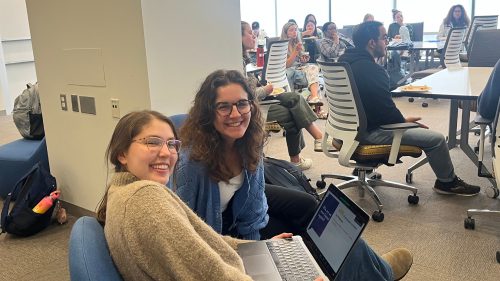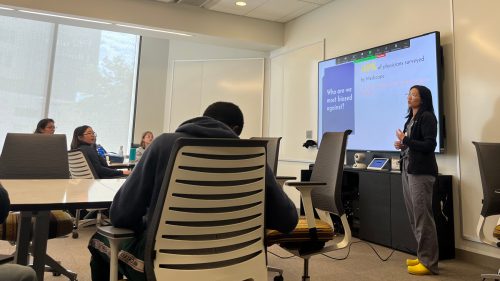Coming into medical school, we knew we wanted to make an impact in the University of Michigan Medical School (UMMS) community by following our passion for improving equity, representation and inclusion. One student group that particularly caught our attention was the Student Diversity Council (SDC), which works to ensure the medical school community promotes diversity, equity, inclusion, accessibility and justice (DEIAJ). SDC also works closely with the administrators to amplify student voices in various medical school decisions.
 Following a small group discussion in the medical student lounge (also known as the Slounge), we discovered our mutual interest in diversity promotion. We reached out to the leadership team of SDC hoping to find a way to make an impact, specifically how we might be able to help improve our M1 curriculum. We were shocked and thrilled by how receptive SDC was to our ideas and passion for improving DEIAJ in the curriculum and how they welcomed us with open arms. Every member of SDC comes to the group with their own personal motivations and ideas for initiatives, so we felt we had a lot of support and resources to help us enact our own project!
Following a small group discussion in the medical student lounge (also known as the Slounge), we discovered our mutual interest in diversity promotion. We reached out to the leadership team of SDC hoping to find a way to make an impact, specifically how we might be able to help improve our M1 curriculum. We were shocked and thrilled by how receptive SDC was to our ideas and passion for improving DEIAJ in the curriculum and how they welcomed us with open arms. Every member of SDC comes to the group with their own personal motivations and ideas for initiatives, so we felt we had a lot of support and resources to help us enact our own project!
Our first project centered around patient presentations in the Scientific Trunk, the first year of pre-clinical studies at UMMS. Patient presentations are sessions where real patients tell their story and answer questions directly from students. While patient presentations during the Scientific Trunk served as opportunities to learn about the pathophysiology of disease, we found that students wanted to hear more about the impact of socioeconomic status, race and ethnicity on the patients’ health and journey through the health care system.
We worked alongside Hana Murphy, a fourth-year medical student, to conduct a survey to assess students’ thoughts about diversity in patient presentations. The overwhelming opinion from students was that they wanted to hear more from patients of diverse backgrounds, including representation of different race, ethnicity, gender, socioeconomic status, sexuality, educational status and ages. We brought the results of the survey and ideas for strategies to improve patient presentations to the Scientific Trunk faculty. We discovered the Office of Patient Experience, a department within Michigan Medicine that integrates patient perspectives by sharing their stories with the goal of maintaining and strengthening a patient-centered culture of care.
Our idea was to incorporate videos of patient stories from the Office of Patient Experience website into the Scientific Trunk. As a team, we went through each video and designated which part of the curriculum each story would best supplement. This helped contextualize the pathophysiology of specific disease processes with real-life patient experiences with more varied backgrounds. With the help of Scientific Trunk faculty, we were able to begin to more officially integrate these resources into the M1 curriculum.
As we progressed through our M1 year and the M2 clinical year rapidly approached, we began to think about how we could continue to incorporate values of DEIAJ into our education. Hana shared an experience she had prior to her emergency medicine clerkship where Dr. Marcia Perry, Assistant Professor and Associate Chair for Diversity, Equity and Inclusion in the Department of Emergency Medicine, and Dr. Samantha Chao, PGY-4 in Emergency Medicine, discussed strategies to minimize bias in clinical notation. She thought that the messages from their talk could be incredibly valuable to students before they entered the clinical setting, and we agreed.

Dr. Chao presenting at the lunch event.
SDC hosted “The Power of Language in Clinical Documentation,” a lunch event to incoming M2s led by Drs. Perry and Chao. They led an interactive discussion about their experiences in the Emergency Department and their process of writing and presenting patient information while minimizing bias in their care teams. We looked at examples of notes with biased language and how it might influence providers’ perceptions of patients. They provided us with strategies to advocate for patients as medical students, acknowledging that we are in a position where we might not always feel empowered to correct a resident or attending. These strategies included changing progress notes to remove stigmatizing language and add person-centered phrasing. Other strategies included using the correct language during presentations on rounds, even when other providers might be using biased language.
In just two months of being clinical students, we are already able to put what we learned into practice. After inheriting a patient who had been through many medical services, his “one-liner,” the very first sentence anyone reads about them when looking through his medical chart, described the patient as a “drug abuser.” Changing the one-liner from “drug abuser” to “patient with a substance use disorder” was a small but tangible action toward reducing bias in the clinical space.
While clerkships take a lot of our time, our projects are still ongoing. As we traverse the clinical space, we are mindful of our current experiences and how they will inspire us to take action in the future. If you are reading this and are similarly passionate about DEIAJ work and want to have an impact, please consider working with or supporting the efforts of SDC!
Don’t miss the next Dose of Reality.
Hannah Slater is a second-year medical student at the University of Michigan Medical School who is passionate about working with stigmatized and under-resourced communities. When not running around the hospital, you can find her baking bagels with friends, discovering new coffee shops with her partner or walking alongside the Huron River.
Grace Tremonti is a second-year medical student at the University of Michigan Medical School from Ann Arbor, MI. She is passionate about health policy, improving DEIAJ in the academic and clinical spaces and playing soccer!
